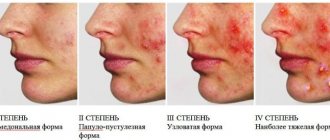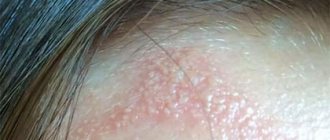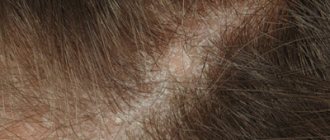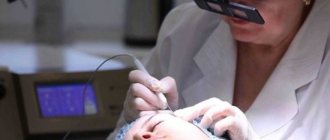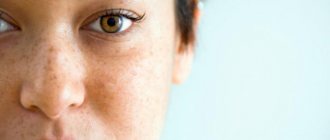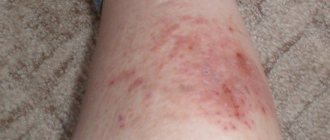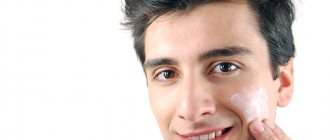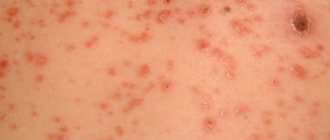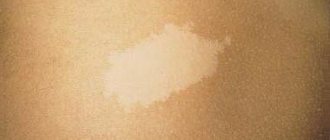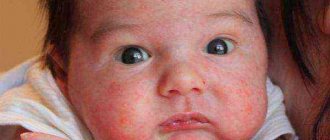Types of rashes
Most often, adults are bothered by the following types of skin rashes on the face:
- bubbles;
- ulcers;
- dense nodules;
- acne;
- closed comedones;
- subcutaneous acne.
The blistering rash is often accompanied by redness of the skin. The bubbles are small in size and their contents are most often transparent. This type of rash may be accompanied by itching.
A pustular rash is in many ways similar to a vesicular rash, but the contents of the rash have a yellowish or greenish tint. The skin around the ulcers becomes inflamed, and pain is felt when pressing on the source of inflammation.
Dense nodules on the skin may be pink in color. They rise slightly above the epidermis and may itch and peel.
Acne is inflammation in pores that are clogged due to excess sebum. Such rashes are located superficially; a distinctive feature is the presence of a visible white or yellow rod in the acne.
Closed comedones are clogged pores. When comedones are damaged and infected, inflamed acne forms in their place.
A small subcutaneous rash on the face appears due to the inflammatory process when the skin becomes infected. These pimples look like small pink bumps. When pressing, pain may occur.
What kind of rash occurs on the back, shoulders and neck?
As you know, a rash is a symptom that is a pathological change in the skin. It, depending on the reasons, varies in pattern, location and size, shape and can occur anywhere on the body. For example, it may appear as dots or spots that are raised, scaly, flaky, or filled with fluid, including pus. The rash may also be accompanied by additional symptoms - itchy or non-itchy, painful, hot to the touch. All these characteristics also apply to the rash, which may appear on the back of the body.
Causes of the rash
Different types of rash have different causes. If a rash suddenly appears on the face, the following possible causes of this reaction are identified:
- endocrine dysfunction or hormonal imbalance;
- allergic reaction;
- hives;
- skin irritation;
- chronic diseases of the gastrointestinal tract;
- stress;
- negative impact of climatic factors.
A small red rash on the face may be due to an allergic reaction. In this case, either small bubbles or dense nodules may appear on the skin. If you notice a small, colorless rash that itches, hives may be the likely cause.
Specific forms
Unusual varieties of papules include:
- Fibrous. The second name is melanocytic nevus or mole. This type of nodule appears on or around the skin of the nose. The formation looks like a spherical brown papule measuring 0.5–1 cm. Its presence is not accompanied by physical illness.
- Lichenoid. One of the forms of allergic rash caused by taking medications. They appear in the form of cone-shaped and spherical nodules of blue or purple colors. Occurs in the bends of the knees, elbows, on the neck (from the spine), buttocks. Associated symptoms are itching and flaking.
- Gottron. This type of papules occurs in a chronic disease of the skin and skeletal muscles called dermatomyositis. They appear on the skin of the phalangeal joints (bends of the fingers) of the hands and feet, which leads to decreased mobility. The nodules look like dark red or purple oval spots 3–5 mm in diameter.
- Mother of pearl. Behind this name lies harmless ball-like rashes of a characteristic pearlescent color at the base of the head of the penis. This pathology is not transmitted through sexual contact and is a skin pathology of unknown etiology, that is, the reasons for its appearance are unknown. Presumably this is a normal physiological phenomenon that occurs in boys during puberty. The nodules resolve on their own by age 25.
- Mantoux test. Another name for this type of papules is tuberculin test. This medical procedure is performed to assess the presence of immunity to the tuberculosis pathogen. Depending on the size of the papule, the patient’s condition is determined: a diameter of less than 5 mm - everything is fine, a diameter of 5-10 mm - an increased risk of infection or contact with a person with an open form of the disease, a diameter of 15 mm or transformation into an abscess - sick.
Treatment principle
How to get rid of a rash on the face depends on its type. If small acne appears on the face, you must first determine the cause of this disorder and only then begin treatment. In order not to harm your own health or worsen your skin condition, it is recommended to consult a dermatologist before starting self-treatment.
To get rid of rashes, first of all, you should stop using any cosmetics, review your diet and stop taking any medications. This will eliminate allergic reactions and skin irritation due to the use of incorrectly selected cosmetics.
Rash on the back of the neck, shoulders, and sides of the abdomen
The shoulders, back of the neck and side of the abdomen are areas that are very close to the back. Firstly , a rash that occurs in these places can be caused by a local disease or skin condition, i.e., occurring precisely in these places. This could be clogged skin pores, irritant dermatitis, or insect bites. Secondly , it may also indicate causes affecting the entire body, for example, chicken pox or other infections in the blood.
The rash can either begin in these places and spread to the back, or appear simultaneously on the back, shoulders, neck and sides of the abdomen.
Alternatively, they may start at the back and then spread to those areas. There are also generalized rashes that can occur on the back, shoulders, back of the neck and side of the abdomen at the same time. A good example of the latter is generalized itching.
It is therefore recommended to quickly respond to any symptom in any of these locations to avoid its spread to other nearby areas.
Effective means
If the skin rash on the face is acne or comedones, treatment includes the use of drying agents. Such products are applied precisely to areas of inflammation.
In case of inflammation of the epidermis, it is necessary to use special ointments. For severe urticaria, ointments containing corticosteroids are used for this purpose, however, such drugs can only be used as prescribed by a doctor due to the large number of side effects or contraindications.
The first thing a patient should do if they have an allergic skin reaction is take an antihistamine. Anti-allergy tablets will quickly relieve itching and relieve swelling of the skin.
Causes
There are many possible triggers and causes. A rash in the back area may indicate a local problem or a general condition of the body, including problems with internal organs.
A common cause of back rash that is usually overlooked is poor hygiene. This is because the back is harder to reach, so it is often not washed as well as other parts of the body. But there are a number of more serious reasons:
Acne (blackheads)
Acne (acne)
The upper back and shoulders are one of the main places where acne vulgaris, the most common form of acne, can appear. This skin condition occurs when the pores of the hair follicle become clogged, leading to the formation of pimples.
These may start out as closed (white) or open (blackheaded) comedones and then develop into other types of skin lesions such as pus-filled boils. Acne can appear on the back and then spread to other parts (face, neck, chest, legs, thighs, etc.) or vice versa - immediately on the face and then on the back. They are usually painful and very itchy.
Psoriasis
Psoriasis (there are several types)
This itchy skin condition can also appear on any part of the body, including the back and neck. It is an abnormal growth of skin cells that do not have time to exfoliate, resulting in thickened skin and severe dryness.
Symptoms of psoriasis include a silvery-white rash with red raised edges and flaky skin. The exact cause of this condition is not known, but it has been associated with autoimmune disorders. Some factors that may trigger its development include:
- some medications;
- smoking cigarettes;
- dry and cold climate;
- stress and depression;
- serious illness;
- drinking a lot of alcohol.
Hives
Hives A
bumpy, itchy, dark red rash on your back could be hives. This condition is usually caused by an allergic reaction. Although there are also non-allergic causes. These include sudden changes in temperature, friction, burns or even extreme physical exertion. For many people, chronic hives are caused by autoimmune disorders.
Prickly heat
Heat rash
Heat rash, also known as heat rash, can result in a very itchy rash after the body is exposed to heat. This manifests itself as redness, itching and tingling of the skin.
Heat rash can be caused by tight clothing, leading to intense friction and sweating. It often occurs in areas such as the armpits, groin, abdomen, chest, back, neck, and other places where there is clothing. The problem most often affects children and active people. Miliaria can also be severe, accompanied by fever and other serious symptoms.
Seborrheic dermatitis
Seborrheic dermatitis (seborrhea)
Seborrheic dermatitis is a common condition that usually affects areas of the skin that produce a lot of sebum. This condition is thought to be responsible most often for dandruff on the scalp, but lesions can spread to the face (especially the beard, eyebrows, nose) and other parts of the body, including the back. The condition can be aggravated by changes in climatic conditions, stress, depression and fatigue. Most likely, this is caused by Malassezia yeast, which lives on the skin and begins to actively reproduce by feeding on sebum.
Seborrheic dermatitis appears on the back, especially in the upper part, in the form of a red rash, sometimes yellowish scales may appear.
Contact dermatitis
Contact dermatitis, although the rash can be different.
These are rashes that occur due to the touch of an allergen or irritant. Examples of products that can have a similar effect are soaps, cosmetics, detergents, and some plants. The rash may or may not be itchy, red, bumpy, or even large blisters.
Tight clothes
The rash may appear due to tight clothing, which can irritate the skin on the back and shoulders. Wearing tight clothing, especially synthetic or rough clothing, is also associated with excessive sweating.
Additionally, washing is often done with strong detergents or fragrances, which can also cause contact dermatitis for people with sensitive skin.
Sunburn
Sun exposure is another potential factor that can cause skin changes. This is especially true for being in the sun without clothing covering your shoulders and back. The skin on the neck is often slightly less affected than these areas.
Sunburn usually makes the skin red, dark, or blistered, also causing a burning sensation. The resulting rash can be very itchy, but lasts relatively short and goes away after a few days if you avoid repeated burns, which is very dangerous.
Eczema (atopic dermatitis)
Atopic dermatitis (eczema)
Atopic eczema is a skin condition associated with an unusual reaction to certain allergens. It begins in childhood and can persist into adulthood and is one of the leading causes of rashes in children. It most often appears on the elbows and the backs of the knees, but can affect other areas of the skin, including the back and neck.
Symptoms include dry, rough, itchy, red skin. Scratching can further cause peeling and bleeding. The cause of eczema is not very clear, but it is associated with allergens, hay fever and childhood asthma.
Infections
Furuncle Impetigo (streptoderma) Shingles Pityriasis versicolor Ringworm Rash due to secondary syphilis
There are various infectious diseases that can be accompanied by rashes, including on the back, neck and shoulders. These include:
- Shingles is a collection of painful, fluid-filled blisters on one side of the body, often in a stripe. The cause is the reactivation of the varicella zoster virus (chickenpox) in people who previously had it.
- Boils or clusters of boils called carbuncles, which are pus-filled lumps (abscess). Most often they are caused by staphylococci, less often by other bacteria.
- Impetigo is a bacterial infection that affects the superficial skin. It is usually caused by Staphylococcus aureus or Streptococcus pyogenes. In the second case, the disease is called streptoderma. Symptoms appear as large, pinkish spots with clearly defined, jagged edges that most often appear around the mouth or limbs, but are sometimes found on the back and neck. Some forms of impetigo appear as blisters filled with fluid.
- Cellulite (disease) is a purulent inflammation of the subcutaneous adipose tissue caused by bacteria entering it. It usually affects the legs, abdomen or arms, but it can also appear on the back.
- Scabies is a small, very itchy rash caused by microscopic mites that make holes in the skin. It most often occurs on the hands, but can appear anywhere.
- Pityriasis versicolor (varicolored) is a chronic fungal infection of the skin, manifested in the form of clusters of small spots with clear boundaries. The disease often affects the back, shoulders, chest, and neck.
- Ringworm (dermatomycosis) is a fungal disease of the hands, feet, and head, although it can appear on any part of the body, including the torso. Raised red rings on the skin are the most typical appearance, but the lesions can look different.
- Secondary syphilis is the stage of syphilis that occurs approximately 10 weeks after infection and is accompanied by rashes over the body.
Generalized itching
Generalized itch is a strong urge to scratch the skin in various areas of the body or even throughout the body, usually caused by internal health problems. The resulting scratches can cause secondary skin changes such as irritation, lichenification, dryness, eczematization and infection. Simply put, rashes on the back, neck and shoulders can occur because a person has scratched them due to an internal condition.
Possible causes of generalized itching include:
- Blood diseases.
- Hormonal disorders.
- Oncological diseases.
- Kidney disease
- Diseases of the gallbladder, liver or bile ducts.
Other reasons
- Neurodermatitis is a neurological skin disease that results in scaly patches on the neck, head, feet, ankles, and arms.
- Dry skin.
- Certain plants containing substances such as urushiol, some coumarins/furocoumarins, e.g. poison ivy, hogweed.
- Epilation, shaving hair on the back.
Burns of various origins
The most common type of burn on the face is sunburn. If a person is under the scorching sun without a hat, his face turns red, itching begins, and a small rash appears. Similar in appearance to solar thermal burn.
Sunburn
Chemical burns occur due to non-compliance with safety precautions when using products containing acids and aggressive substances. If the causes of a rash on the face of an adult lie in damage to the skin due to a burn, superficial treatment with ointments and creams is used.
Don't miss one of the most useful articles about: Nagging pain in the lower abdomen in women - causes
Diagnostics
The rash can accompany various diseases. The doctor carefully examines the patient before making a diagnosis. He knows what disease causes this or that type of rash, and on what day it appears.
Diagnostic measures include examination of the patient and conversation with him. This is followed by an assessment of the skin with palpation of the papules. The procedure should be carried out in good lighting and a thorough examination of the entire body.
When diagnosing, not only the nature of the rash is taken into account, but also other clinical manifestations. For example, the presence of a runny nose, cough, fever, etc. The doctor prescribes laboratory tests.
A rash in a child can be a manifestation of both acute and chronic infectious diseases. Diagnosis is also carried out according to a number of signs.
Causes of goosebumps
The causes of goosebumps can be pathological or normal. The latter are not dangerous. These include strong emotions, freezing, staying in one position for a long time, etc. There are several pathological causes of goosebumps. Most often, such a reaction is caused by injuries, metabolic disorders, vitamin deficiency, especially a lack of B vitamins, and paresthesia can also appear with diabetes, osteochondrosis, atherosclerosis, alcoholism and be a side effect of the use of certain medications.
With diabetes and alcoholism, goosebumps may indicate the development of polyneuropathy, which is called diabetic or alcoholic because of its appearance. In addition, there is inflammatory demyelinating neuropathy, accompanied by goosebumps. This disease is an autoimmune disease and usually progresses rapidly. At the beginning of the disease, goosebumps appear on the skin, then the muscles involved in the breathing process begin to weaken, and then the rest of the muscles of the body. Such manifestations are called Guillain-Barré syndrome.
The occurrence of paresthesia in the extremities requires special attention, as it indicates a lack of blood supply and possible angiopathy. These symptoms are typical of restless legs syndrome. In terms of its symptoms, this disease is very similar to polyneuropathy, but its development mechanism is somewhat different. Restless legs syndrome is considered a fairly serious pathology.
What diseases cause goosebumps
The appearance of goosebumps can indicate various diseases, such as:
- hyperkeratosis, or increased keratinization of the upper layer of skin;
- restless legs syndrome, which develops with renal failure and other pathologies;
- hormonal imbalance, most often, pathologies of the thyroid gland or adrenal glands manifest themselves in a similar way;
- diseases of the cardiovascular system: atherosclerosis, varicose veins, arrhythmia and others;
- diabetic polyneuropathy, which occurs in patients with diabetes mellitus;
- autoimmune pathologies accompanied by Guillain-Barré syndrome;
- stress, neuroses, nervous disorders;
- arthrosis and osteochondrosis. With arthrosis - goosebumps run in the neck area, with osteochondrosis - the localization of the goosebumps depends on which part of the spine is affected;
- migraines, tumors and inflammation of the brain, with these diseases goosebumps are felt on the face and scalp;
- injuries, nerve compression, muscle inflammation, etc.
Allergy products
Allergies are one of the most common causes of facial rashes in adults. The list of allergens includes plant pollen, animal dander, cosmetics or medications. But more often, itching and inflammation are provoked by food or its components.
Products that cause allergies
If you are prone to allergies, pay attention to the quality of the products; do not eat sweets, citrus fruits, or eggs. With allergies, the skin swells, the disease manifests itself as itching and lacrimation.
Treatment of rashes on the face
To avoid complications that entail serious consequences, the patient should contact a medical specialist who will give recommendations regarding questions about how to treat a particular type of rash.
For an initial examination and diagnosis, it will be enough to see a therapist or dermatologist.
When a doctor sees that a person needs consultation with a more specialized specialist, he refers the patient to an immunologist, gastroenterologist, gynecologist, or endocrinologist. The choice of specialist depends on the information received from the patient regarding the time of occurrence and the nature of the manifestation of the rash.
Treatment directly depends on the cause of the disease and the distinctive features of the rash.
In order to eliminate allergic rashes on the face in adults, a medical specialist may prescribe ointments, tablets, lotions and creams.
It is important to note that during treatment it is necessary to change your usual lifestyle and switch to a healthy diet. A woman is recommended to reduce to zero the use of foundation, concealers, powder and other means to correct the appearance of her face.
Squeezing out rashes of any kind is strictly prohibited. This can significantly increase the area of inflammation and lead to the formation of a new rash. When performing the procedure of cleansing and lubricating the skin, you should use a gauze swab or a disposable napkin.
If the rash itches a lot, you should take an antiallergic drug.
Based on the results of tests and examinations, a specialist may prescribe the following medications:
- if the rash is of an allergic nature - Zodak, Allegra, Fenistil;
- if the rash is of infectious origin - antimicrobial ointments, for example, Sintomycin;
- if the rash is caused by the herpes virus - Acyclovir;
- if the rash is caused by sunburn - Panthenol;
To avoid scarring, experts recommend using an oil solution of vitamin E.
To treat rashes, a medical specialist prescribes complex therapy, which includes not only the use of ointments, creams, but also taking tablets. If everything is clear with the last type of medication, then it is worth understanding with regard to drugs used externally.
A large number of ointments and creams that are prescribed for the treatment of skin rashes have the following varieties:
- hormonal ointments are the most effective ointments that eliminate the inflammatory reaction, relieve unbearable itching, burning and redness. Medicines: Hydrocortisone, Afloderm, Prednisolone;
It is important to understand that the use of this type of medication is allowed only for its intended purpose, on the recommendation of a doctor, since independent use can lead to serious complications from the body.
- antihistamines - reduce redness, eliminate itching and allergic reactions. Preparations: Fenistil, Psilo-balm;
- combination medications that include several components. Such medications may contain hormones, antifungal and antiseptic elements. Products that can quickly stop the inflammatory process, soften wounds and have a healing effect. Preparations: Triderm, Lorinden.
In addition to medications, you can get rid of rashes using traditional methods. To reduce swelling and temporarily relieve itching, wash with cold water or apply an ice compress to the rash.
Adherents of alternative medicine note that they are helped by wiping with alcohol or vodka those areas that were attacked by an allergic reaction. You can apply an alcohol swab to the area of the rash and leave it for a few minutes.
It is important to understand that independent choice of treatment methods can lead to negative results.
This applies to both the choice of traditional methods and the use of medications. All medications should be discussed with a healthcare professional. Moreover, only a doctor can prescribe a strong, effective medicine, which cannot be purchased at a pharmacy without a prescription.
Any type of rash should not be ignored and masked with cosmetics. This is due to the fact that the skin is a kind of barrier that protects the body from various microbes. Lack of proper and timely treatment of the rash can lead to loss of the protective properties of the skin and the development of the disease.
Rashes may indicate the development of a more serious illness, which will rapidly develop and worsen the condition of the body. Therefore, timely treatment will lead to complete recovery. Moreover, the specialist will tell you how to prevent rashes so that they do not appear on the face.
Nervous disorders
Stress, conflict situations, and strong emotional experiences provoke a rash on the face of an adult. The reasons lie in the effects of adrenaline and vasopressin, which are intensely produced by the body in a state of nervous shock.
It is the rapid release of these hormones that disrupts normal blood flow to the skin , and it does not receive the necessary nutrients.
You might be interested to know about: Quick-acting laxative in tablets
